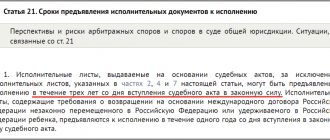Last modified: January 2021
There are often situations when the alimony payer promises to pay more than what is required according to the documents. However, in order to fulfill their promise, payers ask to revoke the writ of execution for alimony. Or, on the contrary, they explain their request by saying that the writ of execution puts them into a “deeper debt hole,” since if the amount of debt is not paid on time, then confiscation of property will follow, and possibly criminal prosecution. What happens if the writ of execution is revoked? What will happen to child support arrears? Is it possible to resume the collection of money for the child after the revocation? About all this in the article below.
Is it possible to withdraw the application?
Alimony is paid only according to executive documents - a voluntary agreement, a court order or a writ of execution. After contacting the bailiff service with the appropriate application, enforcement proceedings are launched. The procedure for disposing of executive registers is regulated by the Federal Law “On Enforcement Proceedings” dated October 2, 2007 No. 229-FZ.
The law regulates both how to use executive documents and how to withdraw an application for alimony. The application for alimony must be collected within 5 days after it is submitted, since after this period the Federal Bailiff Service (FSSP) will begin to formalize enforcement proceedings. Despite the fact that there is no significant difference between the withdrawal of a writ of execution and an application for alimony, taking away the register of enforcement proceedings is more difficult than applying for financial support for a minor.
There can be many reasons for a recall. They are not regulated by law and are not official in nature. Typically, the withdrawal of an application for alimony is initiated by the recipient himself. The court may decide otherwise (if the revocation occurs in court), because refusal of alimony may entail a deterioration in the financial situation of a minor child and a violation of his financial interests. Moreover, the Family Code of the Russian Federation strictly stipulates the responsibility of parents to provide for their minor children.
A parent may voluntarily refuse to receive child support, since this is not prohibited by law. If a party is able to independently ensure the normal functioning of their child without forcing the finances of the second parent, then withdrawing the application will not be difficult.
The motives can be completely different - from psychological, when the parties are on bad terms and do not want to interact with each other, to completely rational ones. An example would be the sudden dismissal or serious illness of the alimony payer. If the financial or social situation worsens, paying alimony becomes very difficult, therefore, the recipient may decide to withdraw the application for such payments.
How else can you explain the withdrawal of the application? The reason may be an official change in the collection procedure - the obligation to pay the minor’s financial support is transferred from one party to the other. Parental rights to a child can also be transferred. The court may even deprive the alimony payer of parental rights by specifying in its decision how to distribute the obligation to pay alimony. You can also withdraw your application due to the employment of a minor with subsequent receipt of income.
Parents may have various reasons for withdrawing an application. However, if the interests of the child are infringed, and representatives of the guardianship authorities prove this, then the court may oblige the parent to pay child support without fail (Parts 2, 3 of Article 80 of the RF IC).
As in the case of drawing up writs of execution, you can withdraw an application for alimony in three ways:
- at a notary's office by drawing up an appropriate agreement;
- in the bailiff service before the initiation of enforcement proceedings;
- in a court.
The choice of authority is made depending on how far the alimony case has gone. If the parties have no particular objections, then the issue is resolved peacefully by drawing up an agreement. If funds for the maintenance of a minor are already being collected, then court intervention cannot be avoided.
Revocation procedure
A full revocation is made only upon the alimony recipient’s application to the local or territorial FSSP authorities. The right of withdrawal is contained in Art. 46 Federal Law No. 229. Next, FSSP employees will ask you to fill out a corresponding application form.
The application does not have a clear form, since it is filled out in a free (free) form and in each individual city or region the application may differ slightly.
However, this document must contain the following information:
- Name of the authority where you applied (ROSP, FSSP, OSP).
- Details of the person collecting alimony and the payer.
- The number of the regulatory legal act (its details) on the basis of which the writ of execution was issued (for example, the number of a court order or a decision of an administration official).
- The essence of the request for the return of the writ of execution.
- The request must be substantiated by reference to Art. 46 Federal Law No. 229.
- Date and signature of the applicant.
Download the Application for revocation of the writ of execution. Sample (27.0 KiB, 549 hits)
Application for revocation of the writ of execution for alimony. Fill sample (17.7 KiB, 709 hits)
How to withdraw a voluntary application?
Filing an application for child support is an official recognition of the obligation of one of the parents to pay financial support to a minor dependent. If the parties have no disagreements, then they draw up a voluntary agreement in which they reflect all their terms.
In the contract, you can refuse monthly payments and offer another option for financial assistance - real estate or property assets. Parents can also discuss the option of making a one-time payment of the entire amount due. In this case, an application for alimony is not drawn up, which means that the parties do not have problems with how to collect it.
In order for the alimony agreement to receive legal force, it must be certified by a notary. The initial agreement must necessarily indicate the payer's contribution to providing for the minor child, otherwise the notary will simply refuse to certify it.
If during the execution of the agreement one party decides to voluntarily refuse alimony, then the agreement must be amended accordingly and then signed by a notary.
How to withdraw an application from bailiffs?
The applicant can withdraw the application for alimony from the bailiff service within up to 5 days. After this period, the writ of execution will have to be revoked. This does not change the right of the alimony recipient to refuse alimony.
To complete the enforcement proceedings, a special application is submitted to the territorial branch of the SSP. In the text of the appeal you must indicate:
- Recipient's name and address;
- Full name and address of the payer;
- name and number of the bailiff service department;
- name and details of the writ of execution;
- terms of payments under a court decision;
- requirement to withdraw an application for alimony;
- grounds that clearly explain the position of the parties.
The SSP considers the application for no more than 4 days and makes its decision. If all the rules stipulating how to withdraw an application for alimony are met, the bailiff will prepare a decree to complete the collection.
The child must be provided for by his parents until he comes of age, therefore the alimony recipient has the right to apply for the recovery of maintenance again.
A citizen can exercise this right at any time before the end of the parties’ obligations to provide financial support for minor children (up to 18 years of age for a dependent). If one of the parties decides to withdraw the application for alimony, this will in no way prevent it from being resubmitted in the future.
Where to contact
To complete the procedure, write an application to the territorial division of the FSSP addressed to the bailiff in charge of your case. This can be done not only during a personal appointment, but also electronically, in the latter case you will not have to leave your home.
You can revoke a writ of execution through a bailiff; you do not need to go to court for this.
If alimony is collected through the employer
If the debtor has official income, part of the debt will be automatically deducted from his salary card. In this case, enforcement proceedings are actually in the hands of the accounting department.
The procedure will be similar. The party submits an application to the bailiff, who considers it and makes a decision.
If the answer is positive, the information is sent to the debtor’s official place of work. After a few days, the write-offs stop.
The FSSP representative has the right to interact not only with the employer, but also with the banking organization that actually writes off the money.
How to withdraw an appeal through court?
Now let’s find out how to withdraw an application for alimony when initiating legal proceedings. The appeal must be submitted to the same judicial body that made the initial decision, or to the arbitration court at the location of the bailiff (Part 1 of Article 45 of the Federal Law No. 229-FZ).
This process involves several stages:
- The applicant formalizes the response by drawing up an application for waiver of claims. The parent must provide the court with reasons for their decision to refuse.
- The judge considers the presented arguments regarding compliance with the rights and material interests of the child, involving the guardianship service.
- The process is completed if the verification does not reveal any violations in relation to the minor dependent. After the judge makes a decision, the plaintiff can withdraw the application for alimony.
In the appeal, the applicant must indicate the reasons for the revocation and attach to the letter a copy of his passport, the child’s birth certificate and a writ of execution (court order or sheet). As an attachment, you can add an agreement of the parties to waive alimony payments or a receipt for a one-time payment of financial support.
After satisfying the request to terminate the alimony case, the plaintiff sends a notice to the bailiff. Review of this document is carried out within three days. The decision taken comes into force immediately (Part 4 of Article 45 229-FZ).
If the plaintiff decides to refuse alimony before the start of enforcement proceedings, he may not use the received executive document, that is, not send it to the employer or bailiff. In this case, you only need to notify the FSSP of the decision not to initiate enforcement proceedings against the alimony payer.
What are the consequences of refusal?
The revocation of executive documents can only be a temporary measure, while the obligation of parents to provide for their children lasts until their dependents come of age. The court document on alimony does not lose its validity even after the recipient has decided to withdraw his application. Payments can be resumed at any time.
Moreover, if the alimony payer has arrears on current payments, it does not disappear and is not written off when the alimony agreement is revoked. The citizen retains the obligation to repay the debt, only it is now collected not forcibly, but voluntarily. The amount of debt is fixed at the time of withdrawal of the executive documentation.
If, after a lapse of time, the recipient decides to resume alimony payments, he can again enter into a voluntary agreement or a court order. There is no need to update the writ of execution. In such cases, the recipient again turns to the bailiff service with an application to resume payments and presents the previously issued sheet. The bailiff initiates enforcement proceedings and issues a corresponding resolution.
Collection can be carried out even for the period during which the refusal of alimony payments was issued. This can only be done if the bailiffs receive complete evidence of non-payment of funds within the specified time. The period cannot exceed three years.
The bailiffs themselves will calculate the required amount and begin forced collection. If payments have been received, and the alimony payer can provide all the evidence (checks, receipts, bank statements), then funds to support the child will begin to be collected from the moment the enforcement proceedings are resumed.
Sources:
“Family Code of the Russian Federation” dated December 29, 1995 No. 223-FZ
Federal Law “On Enforcement Proceedings” dated October 2, 2007 No. 229-FZ
Why might a recipient of alimony need to obtain a writ of execution?
The reason why the recipient of the substantive funds decides to withdraw the relevant document can be completely different, however, as a rule, it is due to the general agreement. Often, the child support provider and the child's custodian can reach an agreement in which one party agrees to pay a larger portion of the funds from their income than the court order.
The other party is interested in receiving a larger amount, which is why they are interested in the questions of whether it is possible to take away the writ of execution for alimony from the bailiffs, whether this threatens something serious, and what to do if the payer subsequently breaks his promises?
The debtor is most often interested in resolving a controversial situation peacefully, as this will avoid jurisdiction and other serious circumstances.
Important! It is always easier to come to an agreement with the recipient of funds than with the employees of the body, whose actions are governed by the law.







